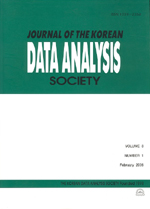한국인 자폐장애진단에서의 판별모형
Discriminant Model for Diagnosing Korean Autism Spectrum Disorders
- 한국자료분석학회
- Journal of The Korean Data Analysis Society (JKDAS)
- Vol.15 No.2
-
2013.04669 - 676 (8 pages)
- 104

자폐증은 사회적 상호작용의 질적 이상과 의사소통의 어려움, 제한된 관심과 반복적인 행동 등의 문제를 보이는 전반적 발달장애이다. 이와 같은 자폐의 진단은 전문가의 판단과 더불어 K-ADI-R, K-ADOS 등의 질문지가 활용된다. K-ADI-R의 진단적 알고리즘은 전체 질문 문항 중 일부를 선별하여 정해진 수치를 기준으로 하여 자폐스펙트럼을 분류하는 방법이다. 본 연구에서는 실제 자폐스펙트럼 데이터분석을 통해 기존 알고리즘의 적절성을 살펴보았다. 또한 진단적 알고리즘에 이용된 문항을 요인분석을 통해 재분류하고, 도출된 요인에 의한 자폐 판별 모형을 의사결정나무 모형에 의해 생성하였다. 도출된 총 11개의 요인 중 3개의 요인이 자폐 판별에 주요하게 이용되어 질 수 있음을 파악하였고 의사결정나무 모형에 의한 분류가 자폐 판별에 보다효율적일 수 있음을 확인하였다.
Autism spectrum disorders are characterized by disturbances in 3 domains which are social interaction, communication, and the presence of restricted patterns of behavior or interest. Besides the professional decision of child psychiatrists, Korean version of the autism diagnostic observation schedule (K-ADOS) and the autism diagnostic interview-revised (K-ADI-R) are used to confirm the diagnosis. Especially, in this study we investigated the appropriateness of the diagnostic algorithm of K-ADI-R is using small part of items from K-ADI-R. The items which are used for diagnostic algorithm are grouped into 11 factors by factor analysis. Decision tree model was applied for building a classification rule of ASD (autism spectrum disorders). Only three factors of 11 are mainly used for classification. We confirmed that decision tree model can be a effective method for classifying ASD.
1. 서론
2. 방법
3. 결과
4. 결론
References
(0)
(0)